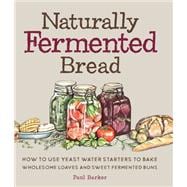Like sourdough baking, yeast-water or botanical bread baking draws on the amazing process of fermentation and the ancient art of breadmaking. The method described in this book, while unique, is informed by the author’s knowledge of both bulk fermentation and sourdough bread baking, resulting in an innovative process and delicious, nutritious results.
To bake naturally fermented bread—fruit, vegetables, plants, or flowers are submerged in water and left for a few days to a few weeks to ferment. Yeasts living in this newly fermented water, or botanical water, will, like a sourdough starter, raise the dough more slowly than commercial fresh or dried yeast resulting in a more flavorful and gut-friendly bread.
You can use this technique to make traditional long-fermented loaves and also a range of sweet fermented buns that showcase the subtle and surprising flavors of your own botanical starters.
Recipes include:
- Tomato and Basil Pizza Dough
- Cucumber Burger Buns
- Chocolate Orange Brioche
- And much more!








